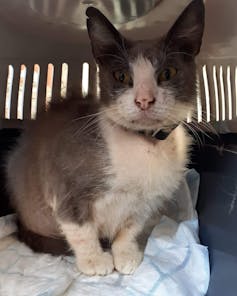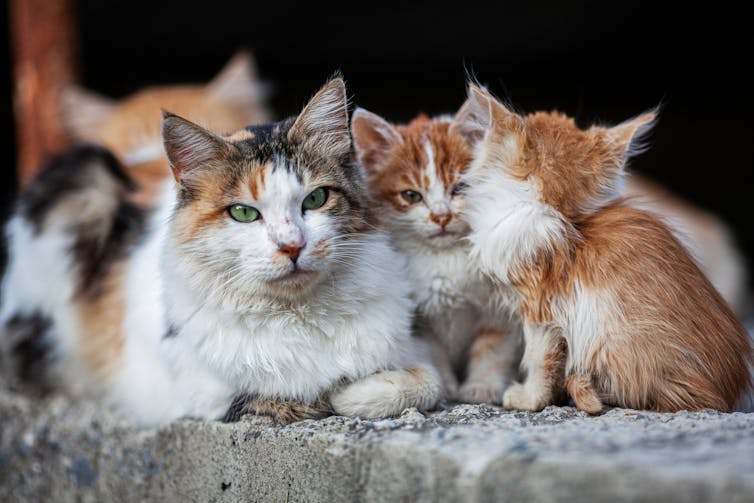250,000 cats have no owners in UK urban areas – but there are ways we can help
We found poorer areas, and areas with more people, were likely to have a greater number of unowned cats.
Oct. 29, 2021 • 7 min • Source
The UK is home to around 10.8 million owned pet cats. But the number of unowned cats living on the streets in the UK has remained largely unknown – until now.
Our new research , published in the journal Scientific Reports, sheds some light on the size of this vulnerable feline group. We’ve estimated there are 247,429 unowned cats across all urban areas of the UK.
Our figure is based on data collected from five urban towns and cities in the UK – Beeston, Bradford, Bulwell, Dunstable and Houghton Regis, and Everton – and then extrapolated. We chose these areas as we suspected they represented a spectrum of unowned cat density, including high density and low density areas.
We used information collected as part of Cat Watch , a community project set up by the UK’s feline welfare charity Cats Protection. Cat Watch encouraged residents to report sightings of unowned cats, initially during door-to-door surveys, and then through an app, social media, and directly to the Cat Watch team. The team worked to verify the information residents provided, resulting in 601 confirmed sightings of unowned cats.
There are a few challenges with reporting unowned cats, such as the fact owned and unowned cats can look the same. So observers may incorrectly identify an owned cat as an unowned cat, or vice versa. There might also be underreporting (because not all unowned cats will necessarily be visible), and multiple reports of the same cat. To account for these potential errors, we developed something called an integrated abundance model , which combined the information from residents with confirmed sightings verified by the community team.

In our five study areas, we found two factors had a significant association with unowned cats in the community. In areas with greater socioeconomic deprivation and higher population density, there tended to be more unowned cats. We applied these findings to the rest of the UK’s towns and cities using official population statistics and socioeconomic data. We calculated the average density of unowned cats across urban areas in the UK to be 9.3 cats per square kilometre, with variation from 1.9 to 57 cats.
We then combined these figures to calculate the national estimate of 247,429 unowned urban cats. While the number is not likely to be exactly right, our statistical analysis tells us there’s a 95% probability the true value lies somewhere between 157,153 and 365,793.
Read more: Compulsory cat microchipping is great in theory -- but the system is flawed
Why so many unowned cats?
The link between unowned cats and socio-economic deprivation isn’t entirely surprising. Previous work has recognised that fewer owned and unowned cats are neutered in deprived areas. When cats are unneutered, populations can expand rapidly.
There are a variety of factors which may explain the association between increased human population densities and increased densities of unowned cats. For example, there would be more pet cats in areas with more people, meaning more cats that can produce accidental litters if unneutered, and more cats that can be abandoned or stray from home. Further, unowned cats will be limited by resource availability. There may be more cats where there are more people because cats have greater access to food in these areas, for example from human food waste.

What can we do?
We need continued research to improve our understanding of unowned cat populations. The predictions from our model increase in accuracy as we scale up to broader geographic areas, meaning our estimates will be more accurate at a national level compared to a street level, where there may be other local differences in cat populations. Areas with the highest human population densities in particular, such as London, require more research, as they were not among our original study sites.
Nonetheless, our research provides useful insight into the scale of the unowned cat population in the UK, and how unowned cat populations may vary across the urban landscape. This information can enable cat welfare charities to direct their support to areas of greatest need.
Read more: The curious character of cats – and whether they are really more aloof
Sadly, without a human caretaker or a regular source of food, water and shelter, unowned cats in urban areas are at heightened risk of many diseases and environmental hazards. Although figures vary, the life expectancy of an unowned cat has been estimated to be around 65% less than that of a pet cat.
Common management practices for unowned cats include rehoming of strays (cats that are used to living in a home but have become lost or abandoned) for whom street life is unsuitable. Unsocialised cats – those that may have been born on the streets and not used to people (often termed feral or community cats) – can be neutered and returned to areas, ideally where there is a cat caretaker who can keep an eye on them and provide food or a shelter . This is commonly termed trap-neuter-return .
Our findings of a close association between unowned cats and human communities suggest that successful cat population management in urban areas will also require supporting cat owners to microchip their cats to prevent them getting lost.
Additionally, it’s important we support owners to have their cats neutered before potential breeding age to prevent any unplanned litters. Our earlier research has highlighted how the long-term effectiveness of any trap-neuter-return and rehoming programs can be improved by simultaneously working with communities to encourage neutering .
Jenni McDonald works for Cats Protection, a UK cat welfare charity.

